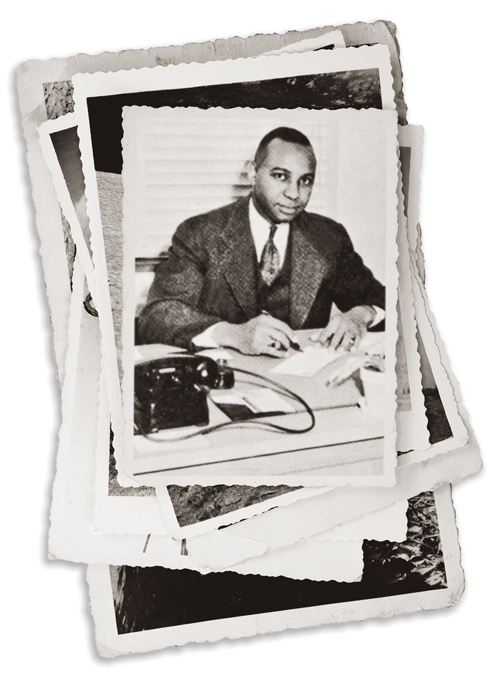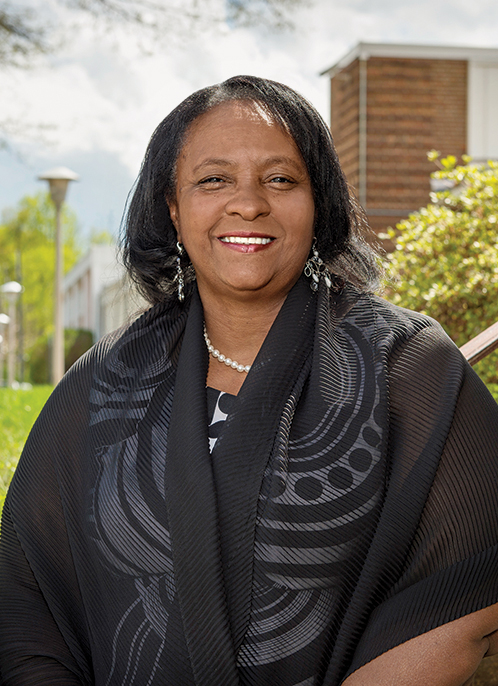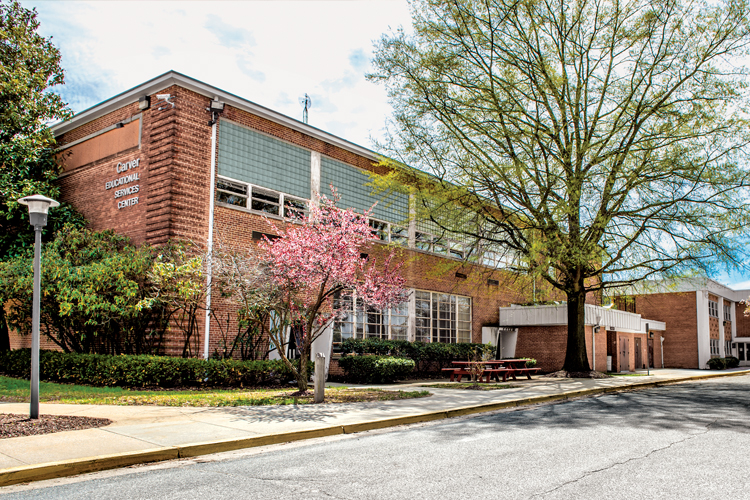Carver Connection
Across Mannakee Street from Montgomery College’s Rockville Campus hides a relic of hope from the days of segregation.
Once an old flat-roofed two-story brick high school, the building today houses the Montgomery County Public Schools administrative offices; but inside, hints of its past remain. The basement cafeteria is preserved much as it may have looked when students first filled it, with a black-and-white checkered floor, chrome-legged chairs and Formica tables.
Throughout the 1950s, this building was the George Washington Carver High School and Junior College. In the parlance of the day, it was a Negro school, the county’s only high school for African-Americans, some of whom spent hours on buses to travel from as far as Damascus and Dickerson to attend.

It was also the county’s only black college, at a time when Montgomery Junior College, still operated under the county’s segregated public school system, barred blacks from attending. Through the twists of history, though, Carver would become Montgomery College’s first Rockville Campus.
Jean Johnson, now 86, was in Carver Junior College’s first graduating class. She remembers commencement day, May 31, 1953, walking across the lawn in her graduation gown—and her dog, Spirit, a big police dog, tearingacross the grass to congratulate her, terrifying the crowd as it bolted a mile from her home to see her.
“Everybody was running and scampering,” she recalls, laughing. “I said, ‘Oh my God, it’s my dog!’”
Schools in Montgomery County had a history of being separate and unequal. The first Negro elementary school opened in 1866. The first high school, Rockville Colored High, didn’t open until 1927, in a building with windows on one side that made some call it a “chicken house.” Blacks could only go as far as eighth grade. By 1931, they could get to eleventh grade. In 1943 they could finish twelfth grade, by then at Rockville’s Lincoln High School.
 Like Montgomery College three years before, Carver Junior College got its start in a high school basement—in this case, Lincoln High. In 1949, Montgomery Junior College Dean Hugh Price headed a Board of Education ad hoc committee to launch a junior college for blacks. He approached Lincoln High School Principal Parlett Moore about serving as its dean. Moore agreed.
Like Montgomery College three years before, Carver Junior College got its start in a high school basement—in this case, Lincoln High. In 1949, Montgomery Junior College Dean Hugh Price headed a Board of Education ad hoc committee to launch a junior college for blacks. He approached Lincoln High School Principal Parlett Moore about serving as its dean. Moore agreed.
In Montgomery College: Maryland’s First Community College, the late William Fox recounts this period, using the terminology of the 1970s:
“As public education in Maryland was then segregated and as there had been no junior college facility in Montgomery County for Negroes, the Board of Education established in August 1950, the George Washington Carver Junior College which was to operate in Lincoln High School with Mr. Moore serving as the dean.”
One year later, the college found a new home at a brand new high school.
“From its opening in 1951, George Washington Carver High School and Junior College was unlike any other county school for African American children,” says Carver: The Heart of a Community, a history published by Montgomery County Public Schools. “Built to modern standards, Carver shined. Former students remember the gleaming floors and pastel walls, unmarred even years later.”
“Carver made a lot of difference in my life,” says Johnson, who studied secretarial work. Others studied mechanics, construction, cosmetology, dry cleaning, tailoring and home economics.
Many lives were changed by Carver, says Anita Neal Powell ’79, a Montgomery College Alumni Association board member who has chronicled Carver’s history and championed its preservation.
Named for George Washington Carver, the scientist most famous for discovering new uses for peanuts, the school “played an important role in the African American community,” Powell says. “It was the only place you could go.”
But it was also a place where faculty watched over students and where, despite a high dropout rate, black students had a chance to succeed.
Then everything changed. In May 1954, with the Brown v. The Board of Education of Topeka, Kansas decision, the Supreme Court ended school segregation. Maryland schools laid plans to integrate.
Carver merged with Montgomery Junior College. After serving 125 students, Carver became Montgomery Junior College’s Rockville Branch. In the spring of 1960, 53 graduates became the last to receive George Washington Carver Junior College diplomas. Segregation at Montgomery Junior College was over.
Carver’s legacy lives on.
Today the building is called the Carver Educational Services Center. Signs throughout the building honor its history as “a place where ambition and dreams were nurtured.” In 2003, supported by Powell’s research, it was designated a Rockville Historic District.
“We’re very proud of it,” says Powell, who also serves on Rockville’s Historic Preservation Board. “We’re very proud of what we were able to do.”
“Classmates still get together. They maintain their history,” Powell says. “When you look at the students that attended the junior college and graduated, they proudly say ‘I am a Carver graduate.’”
—David M. Frey
For more about Carver, visit the new MCPS Carver High School website at www.montgomeryschoolsmd.org/carver.
Leading Us Back
 Alumni Association Board Member Anita Neal Powell, current Montgomery County NAACP president, spearheaded the research that led to Carver’s historical designation. Her work has documented the often forgotten connection between MC and Carver alumni. Powell, a Rockville native, is president/CEO of the Lincoln Park Historical Foundation and oversees the Leroy E. Neal African American Research Center. Her publications include African American Heritage: A Guide to African American Sites in Montgomery County; African American Heritage: A Journey through History; and The Hub of Black Education. She has received numerous awards, citations, and recognitions for her volunteer work and accomplishments, including Maryland’s Top 100 Women for 2007 Award, and the African American Chamber of Commerce of Montgomery County, 2007 Community Service of the Year Award. Her more than 40-year career at the US Department of Health and Human Services includes her current work as a health statistician.
Alumni Association Board Member Anita Neal Powell, current Montgomery County NAACP president, spearheaded the research that led to Carver’s historical designation. Her work has documented the often forgotten connection between MC and Carver alumni. Powell, a Rockville native, is president/CEO of the Lincoln Park Historical Foundation and oversees the Leroy E. Neal African American Research Center. Her publications include African American Heritage: A Guide to African American Sites in Montgomery County; African American Heritage: A Journey through History; and The Hub of Black Education. She has received numerous awards, citations, and recognitions for her volunteer work and accomplishments, including Maryland’s Top 100 Women for 2007 Award, and the African American Chamber of Commerce of Montgomery County, 2007 Community Service of the Year Award. Her more than 40-year career at the US Department of Health and Human Services includes her current work as a health statistician.



